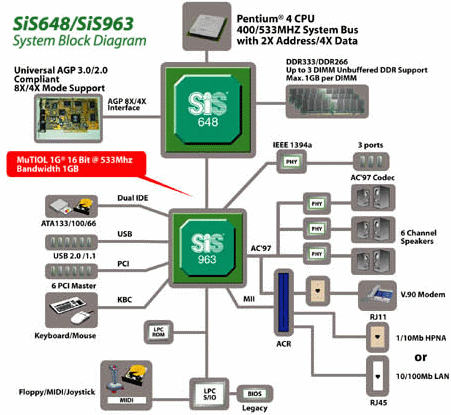Introduction
Things have been going well for SiS (Silicon Integrated Systems) of late. Even before the launch of the new, revised chipset in review for today, the SiS648/963, those of us with a vague interest in motherboards will know just well-regarded SiS' recent offerings have been for both AMD and Intel processors. When I now consider SiS as a chipset designer and manufacturer, gone is the image of them as a producer of substandard, mediocre chipsets. Empirical testing has shown them to be extremely stable, competitive and cheap.
The 648/963 chipset combination is perhaps the culmination of SiS' art for motherboards based on Intel's Pentium4 processor. The original 645 chipset evolved into the 645DX and now into the 648. So, exactly what is new ?. Let's find out.
Looking at the motherboard industry objectively, it appears that chipsets are becoming more feature-rich. Integrations appears to be in-vogue right now. A look at the chipset block diagram should help us understand what's new here.

Starting from the top, the 648 supports all current Pentium4 processors, ones that run on either the older 400MHz or newer 533MHz Front Side Bus (FSB). This is just a continuation of the SiS645DX, one that introduced full support for the newer P4s.
The inclusion of 8x AGP support is something not seen before. This should effectively give us double the bandwidth of the incumbent 4x AGP support found on almost all modern motherboards. Some critics may argue that current video cards cannot make the most of the 1.05 GB/s (4x AGP) of bandwidth currently on offer, so increasing it to 2.1 GB/s is rather academic. However, I tend to see the 8x AGP support as a forward-thinking measure. It also makes implicit sense for SiS as their current Xabre GPU is 8x AGP compliant. The forthcoming Radeon 9700 boasts 8x AGP support, too.
Official system memory support is unchanged from the SiS645DX, DDR266 and DDR333 modules are catered for with a maximum memory capacity of 3GB over 3 DIMM slots, or 2GB in the case of DDR333 memory. The interesting thing, however, is the unofficial support for DDR400 memory. As we all know, the Pentium4 just loves memory bandwidth, so DDR400 support, albeit indirectly, should be seen in a positive light.
The interlink that connects the 648 North Bridge to the also new 963 South Bridge, dubbed MuTIOL by SiS, has also seen an upgrade. The 16-bit bi-directional link runs at 533MHz, giving 1GB/s of effective bandwidth. You may ask why such a fast link, twice the speed of VIA's V-LINK interconnect, is needed. The answer seems to lie in closer examination of the 963 SB.
A quick visual inspection of the 963 South Bridge tells us that it certainly puts an emphasis on features. High-speed peripheral connectivity has been gaining considerable momentum of late. Two of the latest high-speed standards, USB2.0 and Firewire (IEEE 1394a) are both catered for. 6 USB2.0 ports (up to 480 Mbps each) and 3 Firewire ports (up to 400 Mbps each) are integrated via appropriate controllers. Used concurrently, at full-speed, over 500MB/s of bandwidth would be required. The 1GB/s interconnect seems to make sense now.
The IDE controllers have also seen an upgrade to ATA133 standard. I view this upgrade with a little scepticism as it appears we'll be moving to Serial ATA shortly, subjugating the need for ATA133. 6-channel audio support, integrated 10/100 LAN and even a modem connection completes what is a feature-rich South Bridge.
If motherboard manufacturers can fully utilise all the connections on offer, we'll see little need for add-on chips. With this hither-to unseen degree of integration, it'll be interesting if stability is compromised at all.









